 |
 |
 |
| |
Neurocognitive Disorder Rates Differ by US vs Local Standards in Australian MSM
|
| |
| |
Download the PDF here
20th International AIDS Conference, July 20-25, 2014, Melbourne
Mark Mascolini
Two HIV-positive Australian men who had allogeneic hematopoietic stem-cell transplantation (HSCT) with reduced-intensity conditioning (RIC) for hematologic malignancies and continue antiretroviral therapy (ART) have no HIV RNA or DNA detectable by highly sensitive assays [1]. Fourth-generation chemiluminescence microparticle immunoassay (CMIA) can detect only low levels of HIV antigen and antibody in the two men.
Presented at AIDS 2014 just as a report on the two Boston HSCT patients got published [2], the findings add to evidence that RIC-HSCT pulls the plug on some viral reservoirs and largely douses the immune response to HIV. The Boston patients stopped ART and remained off treatment for 12 and 32 weeks, when HIV rebounded. Only the Berlin patient--who had a more intense bone marrow obliteration and transplantation with stem cells from a person homozygous for the protective CCR5 delta32 allele--has remained off treatment for years with no viral rebound [3].
Australian patient 1 was a 53-year-old diagnosed with HIV in 2003 who received RIC-HSCT in 2011 after chemotherapy failed to stop acute myeloid leukemia. The patient continued raltegravir plus tenofovir/emtricitabine (TDF/FTC) throughout the procedure and afterwards. His donor carried the wild-type (unprotective) CCR5 delta32 gene. After the transplant, this man had prolonged lymphopenia (low white-cell count) and only mild, skin-related graft-versus-host disease.
Patient 2 was a 47-year-old diagnosed with HIV in 1987 who underwent RIC-HSCT for non-Hodgkin lymphoma in 2010. His donor was heterozygous for CCR5 delta32, meaning the gene did not provide the full protection conferred by the homozygous gene. The patient continued lopinavir/ritonavir plus TDF/FTC throughout and after the transplant and endured moderate to severe systemic graft-versus-host disease. Likely transplant-related complications included prolonged lymphopenia and cytomegalovirus reactivation.
Two sensitive real-time PCR assays cannot spot HIV RNA in plasma of either patient. PCR sees no sign of HIV DNA in CD4 cells or peripheral blood mononuclear cells (PBMCs). HIV did not become undetectable in the two men until about 3 years after their transplants.
Neither patient has CD4-cell responses to HIV antigen. CMIA and Western blot could detect HIV antigen and antibody in both patients before transplant. Afterwards, Western blot can discern only traces of antibody in patient 2 and no antibody in patient 1. CMIA sees low-level antigen and antibody in both patients.
Both men were treated at Sydney's St. Vincent's Hospital, where David Cooper leads the HIV team. In a Daily Mail interview, Cooper cautioned that "if we stopped the antiretroviral therapy [in these men], there would be a very strong chance that [HIV] would come back" [4]. He suggested scientists can use HSCT "as a model for cure research [to] see if we can develop some therapies that mimic what we're doing with bone marrow transplantation."
Because HSCT will probably be done in a growing number of people with HIV, the Sydney team called for "continued, detailed studies of HIV-infected patients undergoing SCT . . . to elucidate the mechanisms that underlie the profound changes to the immune response and the HIV reservoir described in these cases" [1].
References
1. Koelsch KK, Hey-Cunningham WJ, Sasson SC, et al. Allogeneic bone marrow transplantation in two HIV-1 infected patients shows no detectable HIV-1 RNA or DNA, and a profound reduction in HIV-1 antibodies. AIDS 2014. 20th International AIDS Conference. July 20-25, 2014. Melbourne. Abstract LBPE21.
2. Henrich TJ, Hanhauser E, Marty FM, et al. Antiretroviral-free HIV-1 remission and viral rebound after allogeneic stem cell transplantation: report of 2 cases. Ann Intern Med. 2014 Jul 22. doi: 10.7326/M14-1027. Epub ahead of print: link includes paper
Finding a Cure for HIV: Much Work to Do Editorial - (07/24/14)
3. Hutter G, Nowak D, Mossner M, et al. Long-term control of HIV by CCR5 delta32/delta32 stem-cell transplantation. N Engl J Med. 2009;360:692-698. http://www.nejm.org/doi/full/10.1056/NEJMoa0802905
4. Australian Associated Press, Dean S. Two men 'cleared' of HIV after bone marrow transplants in an Australian first that has sparked hope for eradicating the deadly virus that causes AIDS. Daily Mail. 18 July 2014. http://www.dailymail.co.uk/news/article-2697485/Two-men-HIV-cleared-Sydney.html

Previous studies have demonstrated that good neurocognitive function is important for better QOL and resilience in the face of growing older with HIV infection.
Our results imply that in addition to optimizing cART, in order to enhance neurocognitive function in the large number of aging PLWHA, we also need greater attention to neuropsychiatric comorbidities, particularly substance abuse and depression.
Ultimately, studies should begin to assess the impact of interventions for these comorbidities on ARV adherence and overall health status
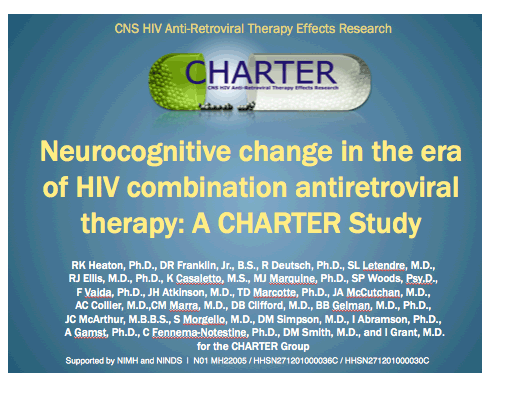

In the U.S., only about 30% of HIV-infected individuals actually benefit optimally from ART by virtue of having an undetectable VL. Of the remaining 70%, a considerable proportion (ranging from 10-50% of those receiving ART) fail to attain virologic suppression, and many more do not receive ART and therefore have active viral replication for a variety reasons. People with SMI, many of whom require treatment with SGAs, are disproportionately represented among those who do not benefit from ART, in many cases because of poor health services utilization and poor adherence to medications. We'll come back to this point in the context of considering whether the increased risk of CV disease is attributable to ART, HIV itself, or both.
A U.S. Centers for Disease Control and Prevention analysis, published on November 29, 2011, indicates that for every 100 people living with HIV in this country, only 80 are aware of their infection, 62 have entered into care and 41 actually stay in HIV care.
Another study of available data, published in a March 2011 issue of Clinical Infectious Diseases, paints a similar picture: Of the 1.1 million estimated to be living with HIV in the U.S., roughly 874,000 have been diagnosed, 656,000 have been linked to HIV care and 437,000 have been retained in HIV care.
In 2010, a CDC analysis of 50 studies conducted between 1996 and 2009 indicated that 30 to 40 percent of people with HIV fail to enter or stay in care after their initial HIV diagnosis.


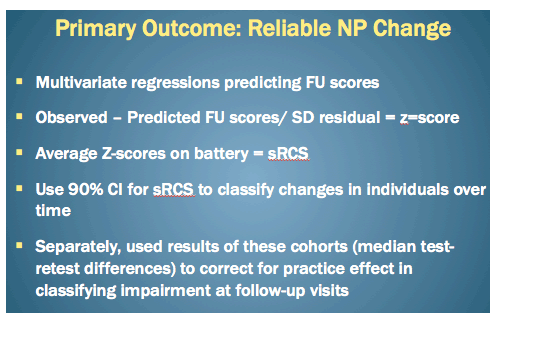
The outcome here, rather than reaching a threshold of impairment or a simple difference score is instead whether the subject ever met during the follow-up interval a criterion for clinically significant cognitive decline as defined byÉ
Published, regression-based norms for NC change were used to generate overall change status (decline vs. stable vs. improved) at each study visit. Survival analysis was used to examine the predictors of time to NC change.
In order to determine NC change, we generated a Z-score for each of 15 neuropsychological variables based on published normative data10. These Z-scores reflect how well or poorly the person performed at follow-up, relative to normal expectation for someone with the same baseline NC and other relevant characteristics (e.g., age, education). The Z-scores were then averaged to provide a summary regression change score (sRCS). The top 5% of the sRCS distribution of the normative sample defined the "improve" range and the bottom 5% defined the "decline" range10. The remaining middle 90% were defined as "stable". NC change status from baseline was generated for each follow-up visit. The individual visit change status for each participant was then merged into an overall change status: 1) Decline: if a participant had at least one "decline" status and no "improve" status across visits; 2) Improve: if a participant had at least one "improve" status and no "decline" status; 3) Stable: if a participant had no "decline" or "improve" NC change status (all visits "stable"). Two participants out of an original cohort of 438 met criteria for both "improve" and "decline" during the follow-up period (at different visits) and were thus excluded from analyses.
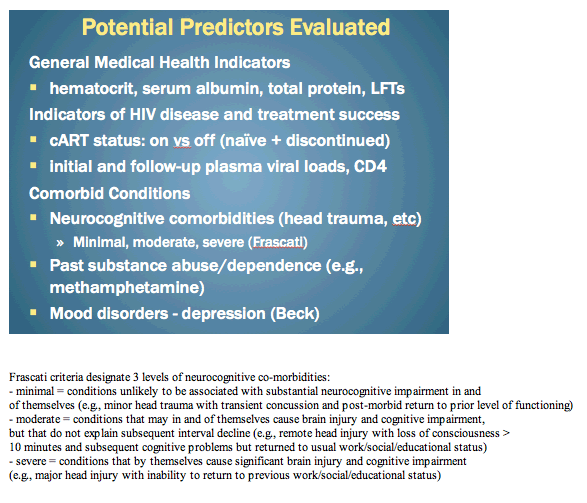


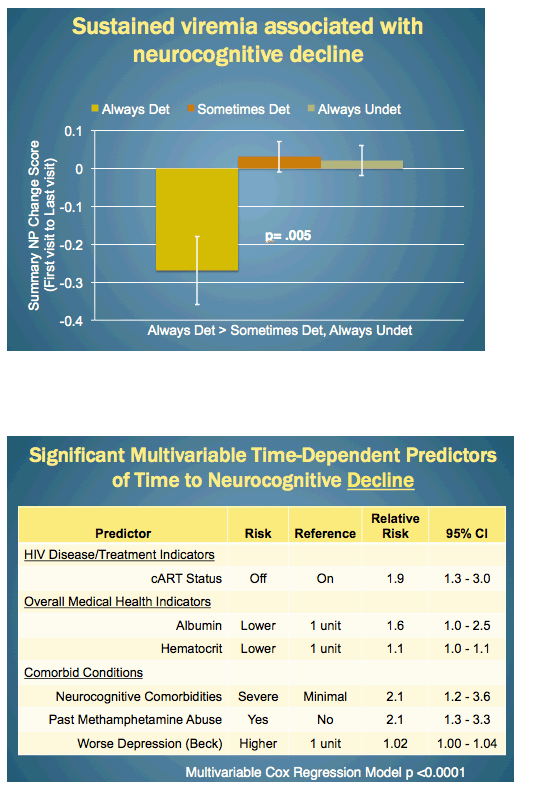
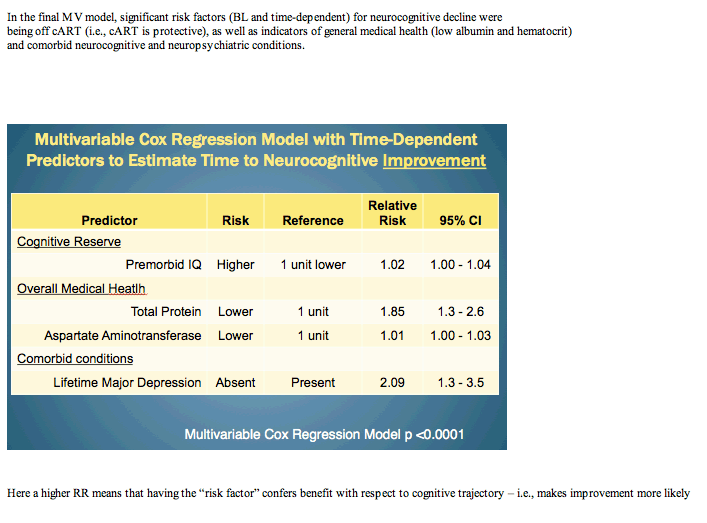

|
| |
|
 |
 |
|
|